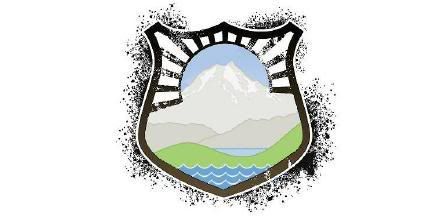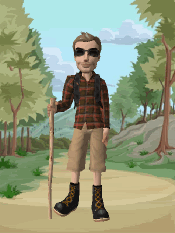DATE: August 10th, 2007
Summary
Starting Elevation: 4,040 feet
Distance: 16 miles roundtrip
Time Hiking: ~12 hours
Time at Top: 1 hour
Ending Elevation: 8,884 feet
Calories Burned: 3,000+
The hike to the top of Half Dome from the valley floor is a 16.4 mile strenuous day hike with a 4,737 elevation gain up to 8,884 feet. Most of the trail that leads
to Half Dome is the John Muir trail which starts at Happy Isles. The distance is longer than it seems to be because the trail takes a large loop around to the opposite side of Half Dome (East Side) before the actual granite ascent begins.
Trail Description
Illilouette Fall: You immediately begin to gain elevation as you move deeper into the canyon where Happy Isles is located. The thick forest at the beginning only allows fleeting glimpses of the river below. At your first view, which is also a decent rest stop, you'll be able to admire the beautiful Illilouette Fall as it plunges 370 feet and joins with the river right below your feet. Straight across and almost straight up you find Glacier Point. Your last view of Yosemite Valley to your right (before you start to approach Half Dome) presents you with a partial glimpse of Yosemite Falls.
Vernal Fall Bridge: At 0.8 miles you reach the Vernal Fall Bridge that beholds a fantastic view of Vernal Fall at 320 feet high. Seen above Vernal Fall is Mt. Broderick to the left and Liberty Cap to the right. As you pass over the bridge, there is a water fountain that you can use to fill up your water bottles. Don't count on this water fountain to work because it is turned off for part of the season and don't ask me which part. You will also find a bathroom with all the amenities.
John Muir Switchbacks: Continuing up from the Vernal Fall Bridge about 200 yards you find that the John Muir trail heads off to the right with a collection of switchbacks that take you to the top of Nevada Fall. This is the way that we come down because it is not as steep and slippery as the trail we are about to go up. A little further up and off to the left there is another Vernal Fall view point that you need to do a little boulder hopping to get to. From this viewpoint, you not only get a closer view of Vernal Fall but the Mist Trail can also been seen to the right of the fall.
Mist Trail: The closer you get to the fall the more you realize why this is called the Mist Trail. Of course, if you go during the latter part of the Summer, you are likely to feel no mist at all. Be careful as you climb the 200 odd very steep and sometimes slippery steps to the top of the fall.
 Vernal Fall: Once you reach the top of Vernal Fall you are greeted by a fenced off area (poles actually) that keep you from getting to close to fall. Do not cross the fence! Several people a year die as they are swept over Yosemite Park's various water falls because they ignored posted safety signs and common sense. Off to the right of this area you find the Emerald Pool fed by the Silver Apron. If it isn't obvious, let me tell you here. This isn't a safe swimming area. And sliding down the apron can easily smash you into the boulders below the surface of the water. I know.
Vernal Fall: Once you reach the top of Vernal Fall you are greeted by a fenced off area (poles actually) that keep you from getting to close to fall. Do not cross the fence! Several people a year die as they are swept over Yosemite Park's various water falls because they ignored posted safety signs and common sense. Off to the right of this area you find the Emerald Pool fed by the Silver Apron. If it isn't obvious, let me tell you here. This isn't a safe swimming area. And sliding down the apron can easily smash you into the boulders below the surface of the water. I know.
Clark Point: After Vernal Fall, the next major stop is Nevada Fall and you have two choices on how to get there. As you follow the trail away from the Emerald Pool you quickly come across a fork where you can head directly towards Nevada Fall (to the left) or towards Nevada Fall via Clark Point (to the right). In my opinion, if you have never gone either way than go left (I like to explore). If you have already gone left, then go right. After you've tried both, you'll notice that the trail to the right (although slightly longer) is much safer and easier as it avoids the steeps steps on the Nevada Fall Mist Trail.
Nevada Fall: If you travel via the Nevada Fall Mist Trail, a new log bathroom waits for you at the top. At this point, if you want to see the top of Nevada Fall before going on to Half Dome, take a right and travel about 200 yards. If you travel via Clark Point, you come across the John Muir Trail about 1/2 mile away from the fork. Make sure you follow the signs and go up (to the left). As you approach Nevada Fall you have a magnificent view Liberty Cap and the 594 foot drop of Nevada Fall.
Little Yosemite Valley: Leaving the top of Nevada Fall on the way to Half Dome the log bathroom previously mentioned is found. Directly after are a few brush switchbacks that take you over a short pass and down into Little Yosemite Valley. As soon as you enter the valley the trail splits to the right and left. The trail to the left (Half Dome Trail) is the most direct course to Half Dome. The trail to the right (continuation of John Muir Trail) will follow the river all the way to Merced Lake and the rest of the High Country. I recommend following the trail to the left. At the point where you begin your ascent out of Little Yosemite Valley towards the base of Half Dome there is another log bathroom visible (towards the river and the camp grounds) midway between the two trails . . . just in case.
Valley Overlook: Although the trail has been steep all the way at least it's been off and on. From here on the steepness doesn't stop. Before you reach the base of Half Dome an overlook of Yosemite Valley and the East side of Half Dome will demand your attention. This overlook is a few yards off the trail but is well worth the stop. From here your vista starts at Half Dome, reaches down across Yosemite Valley, and over to Snow Creek Trail and Snow Creek Valley. The base of Half Dome is about 1/4 further but don't worry, the trail doesn't get any easier.
Hump Ascent: The ascent up the back hump of Half Dome is the most treacherous part of the trail thus far. The trail here is narrow, steep, full of slippery gravel, and it's a long way down. Go slow, let faster hikers by, drink lots of water, and take plenty of rest stops. The more dehydrated and worn out you are, the more likely you are to make a fatal mistake.
Final Ascent: You're finally at the base of Half Dome and are ready to make the final ascent. To do this you need good pair of gloves. If you didn't bring any, a pile of used gloves can be found at the base of the cables. Even though questions of hygiene may arise, it's still better to have a pair of these gloves than none at all. I'd suggest buying a comfortable pair of gloves with a good grip.
 The Cables: There are two cables running up the back of Half Dome. These cables are elevated off the granite with metal poles every few yards. At the site of each of the metal poles is a piece of wood spanning the width of the cables. Standing on the wood is a much easier place to rest because they are more level than the granite mountain being climbed.
The Cables: There are two cables running up the back of Half Dome. These cables are elevated off the granite with metal poles every few yards. At the site of each of the metal poles is a piece of wood spanning the width of the cables. Standing on the wood is a much easier place to rest because they are more level than the granite mountain being climbed.
Summit: Welcome to the world of 360° views. From here you have a more than panoramic view of all the following: Glacier Point, Yosemite Valley, El Capitan, Washington Column, Tenaya Canyon, North Dome, Basket Dome, Snow Creek Valley, Mt. Watkins, Mt. Hoffmann, Olmstead Point, Cloud's Rest, Sunrise Mountain, Mt. Caclure, Mt. Lyell, Mt. Florence, Little Yosemite Valley, Cascade Cliffs, Sentinel Dome, and the list goes on.










